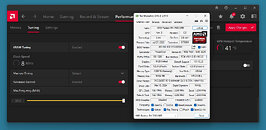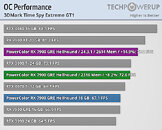- Joined
- Oct 9, 2007
- Messages
- 47,241 (7.55/day)
- Location
- Hyderabad, India
| System Name | RBMK-1000 |
|---|---|
| Processor | AMD Ryzen 7 5700G |
| Motherboard | ASUS ROG Strix B450-E Gaming |
| Cooling | DeepCool Gammax L240 V2 |
| Memory | 2x 8GB G.Skill Sniper X |
| Video Card(s) | Palit GeForce RTX 2080 SUPER GameRock |
| Storage | Western Digital Black NVMe 512GB |
| Display(s) | BenQ 1440p 60 Hz 27-inch |
| Case | Corsair Carbide 100R |
| Audio Device(s) | ASUS SupremeFX S1220A |
| Power Supply | Cooler Master MWE Gold 650W |
| Mouse | ASUS ROG Strix Impact |
| Keyboard | Gamdias Hermes E2 |
| Software | Windows 11 Pro |
Without making much noise, AMD lifted the memory overclocking limits of the Radeon RX 7900 GRE graphics card with its latest Adrenalin 24.3.1 WHQL drivers, TechPowerUp found. The changelog is a bit vague and states "The maximum memory tuning limit may be incorrectly reported on AMD Radeon RX 7900 GRE graphics products."—we tested it. The RX 7900 GRE has been around since mid-2023, but gained prominence as the company gave it a global launch in February 2024, to help AMD better compete with the NVIDIA GeForce RTX 4070 Super. Before this, the RX 7900 GRE had started out its lifecycle as a special edition product confined to China, and its designers had ensured that it came with just the right performance positioning that didn't end up disrupting other products in the AMD stack. One of these limitations had to do with the memory overclocking potential, which was probably put in place to ensure that the RX 7900 GRE has a near-identical total board power as the RX 7800 XT.
Shortly after the global launch of the RX 7900 GRE, and responding to drama online, AMD declared the limited memory overclocking range a bug and promised a fix. The overclocking limits are defined in the graphics card VBIOS, so increasing those limits would mean shipping BIOS updates for over a dozen SKUs from all the major vendors, and requiring users to upgrade it by themselves. Such a solution isn't very practical, so AMD implemented a clock limit override in their new drivers, which reprograms the power limits on the GPU during boot-up. Nicely done, good job AMD!


During the course of our testing of the PowerColor RX 7900 GRE Hellhound graphics card, we were playing around with overclocking using the latest 24.3.1 WHQL drivers, and found that it increased the memory overclocking slider limit in AMD Software, which can be pushed all the way up to 3000 MHz now (24 Gbps GDDR6-effective). Previously the highest possible setting was 2316 MHz. This doesn't necessarily mean that the memory will overclock all the way up to 24 Gbps, you're still limited by what the GDDR6 chips are capable of. Our PowerColor Hellhound ships with Samsung K4ZAF325BC-SC20 memory chips that are rated for 20 Gbps. With our review drivers for the RX 7900 GRE, we had managed a memory overclock of 2316 MHz (18.5 Gbps GDDR6-effective); but with the new drivers, we scored a spectacular 2604 MHz (20 Gbps), which beats the 19.5 Gbps speed that the RX 7800 XT ships with.
The increased memory speed sees our 3DMark Time Spy GT1 overclocked frame rate jump from 72.6 FPS to 77.1 FPS (GPU frequency was constant between the two runs at 2803 MHz). This brings the card's total overclocking potential to an impressive 15% real-life performance gain. It remains a mystery why AMD chose to go with a slower memory sub-system than the RX 7800 XT for the RX 7900 GRE. It may have to do with achieving an almost identical board power number to the RX 7800 XT, so that board partners could end up with the same cooler noise figures as their RX 7800 XT products; or it was just a product segmentation decision—we'll never know. With the 20 Gbps overclock, the RX 7900 GRE has a hearty 640 GB/s of memory bandwidth at its disposal, which should come in handy to keep the 80 RDNA 3 compute units better-fed.
Thanks to @Dragokar for letting us know of the driver change.
View at TechPowerUp Main Site
Shortly after the global launch of the RX 7900 GRE, and responding to drama online, AMD declared the limited memory overclocking range a bug and promised a fix. The overclocking limits are defined in the graphics card VBIOS, so increasing those limits would mean shipping BIOS updates for over a dozen SKUs from all the major vendors, and requiring users to upgrade it by themselves. Such a solution isn't very practical, so AMD implemented a clock limit override in their new drivers, which reprograms the power limits on the GPU during boot-up. Nicely done, good job AMD!


During the course of our testing of the PowerColor RX 7900 GRE Hellhound graphics card, we were playing around with overclocking using the latest 24.3.1 WHQL drivers, and found that it increased the memory overclocking slider limit in AMD Software, which can be pushed all the way up to 3000 MHz now (24 Gbps GDDR6-effective). Previously the highest possible setting was 2316 MHz. This doesn't necessarily mean that the memory will overclock all the way up to 24 Gbps, you're still limited by what the GDDR6 chips are capable of. Our PowerColor Hellhound ships with Samsung K4ZAF325BC-SC20 memory chips that are rated for 20 Gbps. With our review drivers for the RX 7900 GRE, we had managed a memory overclock of 2316 MHz (18.5 Gbps GDDR6-effective); but with the new drivers, we scored a spectacular 2604 MHz (20 Gbps), which beats the 19.5 Gbps speed that the RX 7800 XT ships with.
The increased memory speed sees our 3DMark Time Spy GT1 overclocked frame rate jump from 72.6 FPS to 77.1 FPS (GPU frequency was constant between the two runs at 2803 MHz). This brings the card's total overclocking potential to an impressive 15% real-life performance gain. It remains a mystery why AMD chose to go with a slower memory sub-system than the RX 7800 XT for the RX 7900 GRE. It may have to do with achieving an almost identical board power number to the RX 7800 XT, so that board partners could end up with the same cooler noise figures as their RX 7800 XT products; or it was just a product segmentation decision—we'll never know. With the 20 Gbps overclock, the RX 7900 GRE has a hearty 640 GB/s of memory bandwidth at its disposal, which should come in handy to keep the 80 RDNA 3 compute units better-fed.
Thanks to @Dragokar for letting us know of the driver change.
View at TechPowerUp Main Site







